S.C.ANT
One day in September at lower meadow of Slough Creek, I was hit by the buzzards of flying ants mating swarm. Bugs were all over in the air and on the water and trout kept gulping while it lasted. I was not ready for this sudden event and I did very poorly. Lower Slough is probably the toughest water in Yellowstone Park but also I didn't have right ant patterns. Sizes of these ants were not in general as queens were size 10 or 12 while males were size 20 to 24. I had to develop true imitations and head back to the creek while swarm would last. I came up with great patterns for both queens and males.
Both patterns became life-savers immediately. S.C. apparently stands for Slough Creek. Without these two rises will be very "SCANT" during the swarm.

How to Fish
If you encounter the mating swarm, these two should be trailed and fished together. Also each one will work as one of ant patterns during terrestrial times. At Slough Creek, you have to observe trout's cruising lane and single out one at a time.
S.C.ANT QUEEN
This is the true imitation of what trout are gulping on. It's very buoyant and expresses fluttering silhouette. It works well whether it hits the water up-side or down because those queens last long and struggle very hard before drowned.
Materials:
- Thread: Black 6/0
- Hook: Dai-Riki 280 size 10 & 12
- Body: Brown Foam for Rear Guster and Black Foam for Front Two Segments
- Wing: Montana Fly Company Wing Material
- Legs: Black Bug legs or Span-Flex
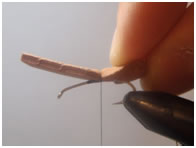
Step 1: Start wrapping thread from the eye to just above the barb. Move back to just in the middle of the hook shank. Tie in a brown foam strip, cut in a hook gape width, from middle of the shank to just above the barb. Form a nice thread base.
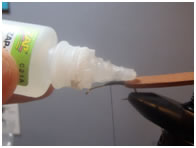
Step 2: Apply Zap-a-gap on wrapping and foam (where folded). Fold the brown foam with 1/3 of hook shank length extending backward, fold back forward, and tie off at the middle of the shank. Hold the folded area till cemented.
Step 3: Tie in MFC Wing Material. Wing should be cut the same width with the foam body and long enough to extend rearward about the half length of rear gaster.
Step 4: Cut a strip of black foam with a hook gap width and tie it in extending forward.
Step 5: Fold the black foam backward and make a front third gaster as you move your thread backward.
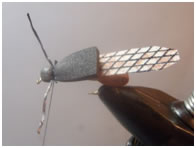
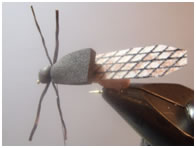
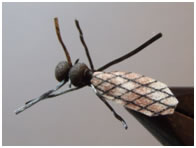
Step6: Tie in legs on both side of the first gaster. Trim off two in the back as it will bother following procedures and to make 3 pairs of legs = 6 legs at the end.
Step 7: Move thread back ward and tie off one more front guster at the meet point of rear gaster.
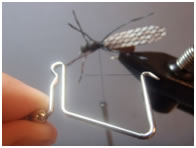
Step 8: Tie in legs on both side in the middle of the fly and whip-finish between second and third pairs of legs.
Step 9: Trim legs in desired length and apply cement on the thread wraps underneath the fly for glossy finish and durability.
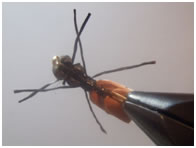
Bottom view
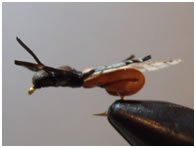
Side view
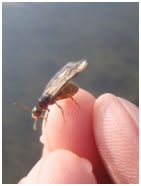
Natural queen ant

Artificial
S.C.ANT BLACK
I used hen cape hackles, rather than cock cape or saddle, for fragility and softness of these tiny males and to make it look like a soft-hackle as well. It should be trailed behind the Queen with a short piece of tippet as if they are mating. Then swing them after dead-drift as if drowned because males are not as buoyant as queens.
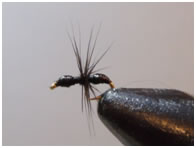
Materials:
- Hook: Standard dry-fly hook size 20, 22, & 24
- Thread & Body: 8/0 Black
- Legs & Wings: Hen cape hackle grizzly or black
Step 1: Start wrapping from the eye and form a front gaster.
Step 2: Precede thread rearward and form a rear gaster. When making these balls, figure-eight wraps help to build up apexes.
Step 3: Coat both balls with cement for glossy looking.
Step 4: Now in the middle of the hook shank, tie in hen cape hackle, and wrap two turns.
Step 5: Whip-finish behind front gaster.
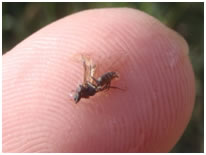
Natural ant
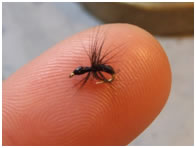
Artificial for comparison
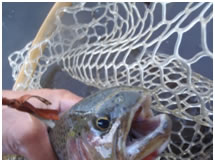
Can you see the ant?
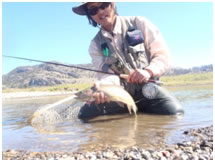
Grip and grin
For more great info, check out:
Beginning Fly Tying | Intermediate Fly Tying | Advanced Fly Tying.
